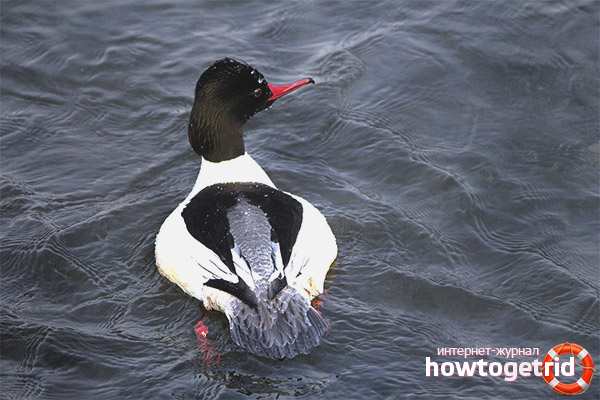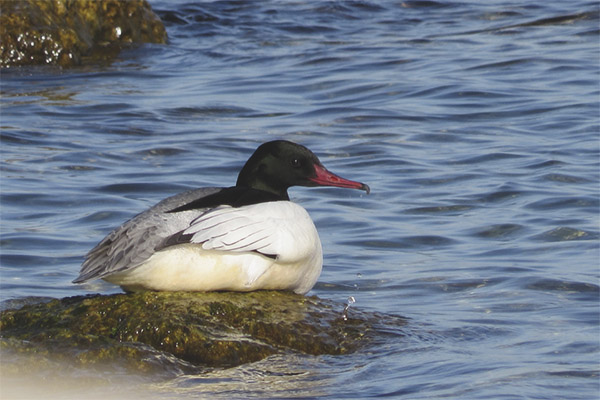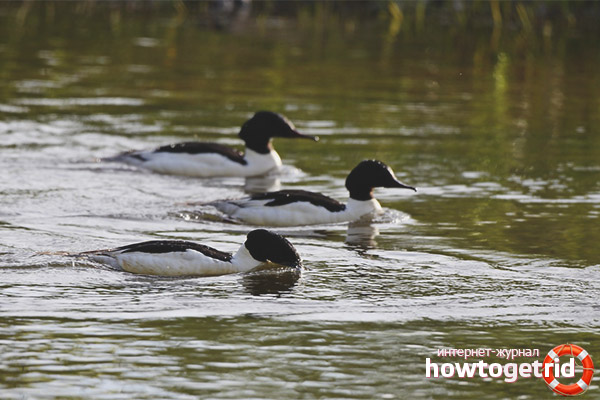The content of the article
Krokhalem is understood as a wild duck, which is widely distributed in the CIS countries and Russia. The bird has become famous for its interesting behavior, dimensional features, plumage and color of the body. Partly for this reason, hunting for these ducks is developed quite extensively. It is extremely rare for individuals of the breed group being discussed to be found near the Azov coast. They spend the winter in warm climatic regions.
Types of merganser
Ducks are waterfowl, there are 4 main species of individuals. In terms of natural habitat, you can find large, long-nosed, scaly merganser and grains. Most often there are large birds that are distinguished by their dimensional features. In winter, their weight can reach 2 kg.
It is these characteristics that make the specimen interesting for hunting.Large-sized merchants prefer to settle and dwell near rivers, lakes that are located near the taiga.
Earlier it was already mentioned that in the natural habitat can be found different lumps. For example, ducks are medium-sized or with a long nose live in the forest belts and tundra of Eurasia. These two species are often intimidated with members of the scaly family.
However, scaly beetles are common in other areas, such as China and the Far East. These individuals are extremely small, with each day their population is declining. To date, there are about 3,000 heads, respectively, about 1,500 pairs. This aspect gave rise to the introduction of individuals of the represented group in the Red Book.
You also can not ignore the following species of ducks of this family, namely the dice. They are the smallest when compared with other individuals. They prefer to settle near trees and in thickets.
Habitat
Birds like flat areas that are famous for their clean water and small amount of vegetation. Individuals try to be exclusively in fresh water sources, circling around the brackish water side.
The name of these birds is fully justified. In terms of dimensional features, these crumbs are really large, that is, they weigh about 2 kg. In males, there is no crest. The head on the black coloring, there is some silver tint in the upper section. The neck at the base is white. The same color of the abdominal part, the sides of the body and some sections of the wings.
If the representatives of the male sex of the crest is absent, then the females can boast a red hair on the head. It is quite wide and forked. The craw and neck are painted white.
When the marriage period begins, the ducks begin to build houses for the future family. For one laying they give about 10 eggs, which are white in color with a creamy shade.
In the category of large krokhaley, there are also some subspecies, which are obtained due to the division into habitats. So, for example, emit Himalayan, common and North American krohal. In the vastness of our homeland, the Himalayan and ordinary subspecies are most common.
Description

To date, this bird is one of the most similar. She in its weight can grow up to 2 kg. As for the length of the hull, on average, these figures vary within 60 cm. If we consider the wingspan, it can reach a meter.
Perhaps this is the only species that can compete with the size of the mallard. As befits individuals of male sex, they are larger than females.
When mating begins, the males put on a bright outfit. On a black or gray head and neck, a flickering ebb of green tone can be observed. Virtually the rest of the body is covered with white feathers. Tail with wings black and gray.
Nutrition
- It is worth paying special attention to the fact that the presented individuals are capable of eating fish up to 20 cm long. In addition, this food is the basis of these birds.
- In addition, the presented ducks eat not simple fish. They prefer salmon and trout. Otherwise, they may eat pike, eel and roach.
- Also, the merganser will consume into the diet that fish that will be most popular in the habitat.
- The birds in question, like the majority of the congeners in the form of a young lady, a turpan, and a white-faced duck, can eat mollusks, small crayfish, worms, larvae, and dragonflies.
Breeding
- Individuals reach sexual maturity approximately in the second year of life. At this age, they become fully capable of continuing their race. To attract a female, the males begin to make sounds characteristic of these birds. After that, the representatives of the stronger sex begin to swim around their darling.
- Thus, the males and lure females. In addition, males can beat their wings on the water, so that they pay attention. After individuals are divided into pairs, they stay in the nesting place. The female is always responsible for the nest.She also proceeds to its construction.
- Often the nest is formed in the hollow of a tree. Nesting can also occur in the deepening of various branches. Often the nests are located in the recesses and crevices of the rocks. A feature of such individuals is that they can have a nest at a decent distance from the water.
- Not all ducks can boast of such. Such a feature for many individuals is simply unacceptable. Most individuals prefer to dwell near water bodies at a distance of no more than 50 m. At one time, the female blows up to 10 eggs. After that, she immediately proceeds to their incubation. A month later, the chicks appear.
- Male for such a long period almost never remains. Therefore, by the time the young appear, it will most likely be gone. The female, in turn, simply waits for the moment when the chicks will get stronger. After that, she leads them to the water. They begin to fly after the second month of life.
Interesting Facts
- The birds in question are unique in nature, they are among the few individuals that prefer large lakes and rivers.
- They need a large water surface in order to take off comfortably.In addition, a lot of free space they need because of the impressive size and great weight.
- Some subspecies of krokhal are listed in the Red Book. In Russia, in almost all regions, their numbers are stable. Therefore, hunting birds is allowed without any problems.
Krokhal belongs to the category of waterfowl, it does not require any special delights in nutrition, it can survive in harsh climatic conditions. Quickly find a place to build a home for the future offspring, as well as high-quality raising hatched chicks.
Video: big merganser (Mergus merganser)












To send